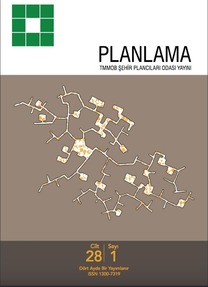Bicycle Route Infrastructure Planning Using GIS in an Urban Area: The Case of İzmir
Kentsel Alanda CBS Kullanarak Bisiklet Altyapısı Rota Planlaması: İzmir Örneği
___
Allen-Munley, C., Daniel, J., Dhar, S., 2004. Logistic model for rating urban bicycle route safety. Transportation Research Record: Journal of the Transportation Research Board, (1878), pp.107-115.Aultman-Hall, L., Hall, F., Baetz, B., 1997. Analysis of bicycle commuter routes using geographic information systems: implications for bicycle planning. Transportation Research Record: Journal of the Transportation Research Board, (1578), pp.102-110.
Barber, M., 2018. 15 cities tackling pollution by curbing cars: From banning diesels to pedestrianizing downtowns, here’s how cities are fighting cars [Online]. Available online at: https://www.curbed. com/2017/4/10/15207926/car-ban-cities-pollution-traffic-paris-london-mexico-city [Accessed August 2018]
Biljeckia, F., Ledouxb, H., Oosteromb, P., 2013. Transportation mode-based segmentation and classification of movement trajectories. International Journal of Geographical Information Science, 27(2), pp.385–407.
Blečić, I., Cecchini, A., Congiu, T., Fancello, G., Trunfio, G.A., 2015. Evaluating walkability: a capability-wise planning and design support system. International Journal of Geographical Information Science, 29(8), pp.1350-1374.
Emery, J., Crump, C., Bors, P., 2003. Reliability and validity of two instruments designed to assess the walking and bicycling suitability of sidewalks and roads. American Journal of Health Promotion, 18(1), pp.38-46.
Governorship of İzmir (2017). Seçilmiş Göstergelerle Türkiye-İzmir (İzmirTurkey with Selected Indicators). Governorship of İzmir Official Website. Available at: http://www.İzmir.gov.tr/istatistiklerle-İzmir [Accessed May 2017]
Handy, S.L. and Xing, Y., 2011. Factors correlated with bicycle commuting: A study in six small US cities. International Journal of Sustainable Transportation, 5(2), pp.91-110.
Heesch, K.C., Giles-Corti, B., Turrell, G., 2015. Cycling for transport and recreation: associations with the socio-economic, natural and built environment. Health & place, 36, pp.152-161.
Huang, Y. and Ye, G., 1995. Selecting bicycle commuting routes using GIS. Berkeley Planning Journal, 10(1).
Huber, T., 2003. Wisconsin bicycle planning guidance, guidelines for metropolitan planning organizations & communities in planning & developing bicycle facilities. Madison: Wisconsin Department of Transportation, pp.1–64.
İzmir Metropolitan Municipality, 2016. İzmir Transportation Master Plan (TMP) Revision. İzmir Metropolitan Municipality Official Website.
İzmir Metropolitan Municipality, 2017. Hedef 2030 (Target 2030). İzmir Metropolitan Municipality Official Website. Available online at: https:// www.İzmir.bel.tr/HaberDetay/22192/tr, [Accessed May 2017]
Kibambe Lubamba, J.P., Radoux, J., Defourny, P., 2013. Multimodal accessibility modelling from coarse transportation networks in Africa. International Journal of Geographical Information Science, 27(5), pp.1005- 1022.
Malczewski, J., 2006. GIS-based multi-criteria decision analysis: a survey of the literature. International Journal of Geographical Information Science, 20(7), pp.703-726
Martens, K., 2007. Promoting bike-and-ride: The Dutch experience. Transportation Research Part A 41, pp.326–338.
Milakis, D. and Athanasopoulos, K., 2014. What about people in cycle network planning? Applying participative multi-criteria GIS analysis in the case of the Athens metropolitan cycle network. Journal of Transport Geography, 35, pp.120-129.
Ministry of Environment and Urbanization, 2017. Şehir İçi Bisiklet Yolları Klavuzu (Urban Bicycle Route Guide). Turkey: MEU. Available online at: http://www.cevresehirkutuphanesi.com [Accessed February 2018].
Parkin, J., Wardman, M., Page, M., 2007. Models of perceived cycling risk and route acceptability. Accident Analysis & Prevention, 39(2), pp.364-371.
Rodriguez, D. A. and Joo, J., 2004. The relationship between non-motorized mode choice and the local physical environment. Transportation Research Part D: Transport and Environment, 9(2), pp.151-173.
Rybarczyk, G. and Wu, C., 2010. Bicycle facility planning using GIS and multi-criteria decision analysis. Applied Geography, 30(2), 282-293.
Saelens, B.E., Sallis, J.F., Frank, L.D., 2003. Environmental correlates of walking and cycling: findings from the transportation, urban design, and planning literatures. Annals of behavioral medicine, 25(2), pp.80-91.
Segadilha, A.B.P. and da Penha Sanches, S., 2014. Analysis of bicycle Commuter Routes using GPSs and GIS. Procedia-Social and Behavioral Sciences, 162, pp.198-207.
Skov-Petersen, H., Barkow, B., Lundhede, T., Jacobsen, J.B., 2018. How do cyclists make their way? A GPS-based revealed preference study in Copenhagen. International Journal of Geographical Information Science, 32(7), pp.1469-1484.7
TurkStat; Turkish Statistical Institute, 2017. Main statistics; Population and Demography. Turkish Statistical Institute Official Website. Available online at: http://www.tuik.gov.tr/, [Accessed May 2017].
Wendel-Vos, G.C., Schuit, A.J., De Niet, R., Boshuizen, H.C., Saris, W.H., Kromhout, D.A.A.N. 2004. Factors of the physical environment associated with walking and bicycling. Medicine and science in sports and exercise, 36(4), pp.725-730.
Wigan, M., Richardson, A.J., Brunton, P., 1998. Simplified estimation of demand for non-motorized trails using geographic information systems. Transportation Research Record, 1636(1), pp.47–55.
WWF; World Wild Fund, 2018. WWF "Tek Dünya Kentleri" yarışmasında Türkiye'den üç kent finalde! (Three cities from Turkey are in finals at WWF "One World Cities" contest!) [Online]. Available online at: https://www.wwf.org.tr/?7701/wwf-tek-dnuya-kentleri-yarismasindaturkiyeden-3-kent-finalde, [Accessed June 2018].
- ISSN: 1300-7319
- Yayın Aralığı: 3
- Başlangıç: 1986
- Yayıncı: TMMOB Şehir Plancıları Odası
Adramytteion Antik Kenti Bütüncül Koruma Planı
Seher BAŞLIK, Mehmet Rıfat AKBULUT
Planlamaya Rağmen Kentte Var Olabilmek: İzmir Konak’ta Bir Kadın Dostu Kent İncelemesi
Mercan EFE GÜNEY, Senem TEZCAN, Ceren AĞIN
Kentsel Alanda CBS Kullanarak Bisiklet Altyapısı Rota Planlaması: İzmir Örneği
Fatma ŞENOL, Zeynep ÖZCAM, Sevim Pelin ÖZKAN
Planlama Perspektifinden Orman Sınırı Dışına Çıkatılan Alanlar Sorunu: İstanbul Örneği
Kenti Sahiplenmenin Veri Altyapısı: Küyerelleşme Sürecinde Kültür Varlıkları Envanteri ve Paylaşımı
Bicycle Route Infrastructure Planning Using GIS in an Urban Area: The Case of İzmir
Sevim Pelin ÖZKAN, Fatma ŞENOL, Zeynep ÖZCAM
İklim Duyarlı Kentsel Tasarım İlkeleri: Erzurum Kenti Örneği
Ankara’da Kentlilik Bilincini Oluşturan Değişkenlerin Faktör Analizi İle Değerlendirilmesi
Leyla Alkan GÖKLER, Sevinç Bahar YENİGÜL, Özge Yalçıner ERCOŞKUN, Ebru Vesile ÖCALİR AKÜNAL
